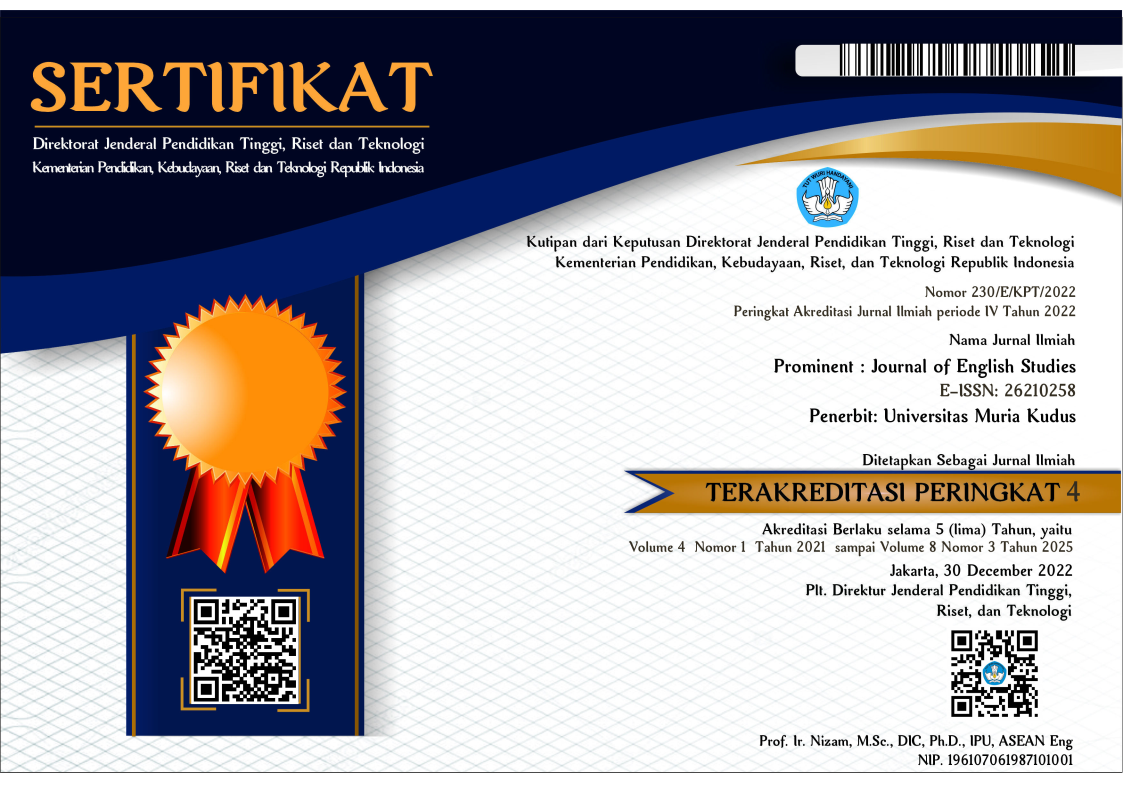THE ANALYSIS OF GENERIC STRUCTURE OF DESCRIPTIVE TEXTS PRODUCED BY COLLEGE STUDENTS
Abstract
Writing is a challenging skill for some English students. Before writing, students must consider the genre. A text type is genre. It's not easy to apply genre theory in writing. The students must comprehend the text's genre, general organization, and lexico-grammatical features. They have lots of ideas but can't put them into a nice writing. This is a big issue for some EFL students. This study examined the impact of genre choice and generic structure on students' writing. The researchers studied the English Class of the Psychology Department of Universitas Muria Kudus. This study is descriptive qualitative. The descriptive qualitative examines the study of students' writings based on genre choice and generic structure. This study was conducted in English class at Universitas Muria Kudus at Psychology Department. Based on the research findings, students' descriptive texts consisted of a generic structure of identification and description. A person's introduction is described in identification. A person is described in a description. Identification and description were well used by all students. Thus, the students consistently used generic structure in their writings. However, there were issues with punctuation, diction, and meaning. This research may help English Education Department, especially students who need to better their texts and think about generic organization and challenges while writing.
Keywords
Full Text:
PDFReferences
Bathia,Vijay K.(2004). World of Written Discourse. Continum.
Durrant, P., & Brenchley, M. (2019). Development of vocabulary sophistication across genres in English children’s writing. Reading and writing, 32(8), 1927- 1953. https://doi.org/10.1007/s11145-018-9932-8
Eggins, Suzanne, and J. R. Martin. (1997). Genres and Registers in Discourse. In T. A. Van Dijk (ed). Discourse as Structure and Process, London: Sage Publications.
Eggins S. (2004). An Introduction to Systemic Functional Linguistics. London: Pinter Publisher.
Gerot, L., & Wignell, P. (1994). Making sense of functional grammar: An introductory workbook. Queensland: Antipodean Educational Enterprises.
Halliday, M., A., K., and Ruqaiya H. (1989). Language, Context, and Text: Aspect of Language in a Social- Semiotic Perspective. Deakin University Press. Halliday, M., A., K. 1994.An Introduction to Functional Grammar. London. Edward Arnold.
Halliday, M., A., K and Christian M. I. M. Matthiessen. (2004) .An Introduction to Functional Grammar. Edward Arnold, London, third edition.
Martin, J., R. (1985). Process and Text: two aspects of semiosis. In J. D. Benson and W.S. Greaves (eds). Systemic Perspective on Discourse. Norwood:Ablex.
Martin, J., R. (1997). Analyzing Genre: Functional Parameters.In F. Christie and J. R. Martin (eds), Genre and Institutions. London: Continum.
Martin, J., R., and Rose, David. (2004). Working with Discourse, Meaning Beyond the Clause. London: Continum.
Madjdi, Achmad Hilal. (2010). English Newspaper Commentaries on the Open Campaign Preceding 2009 Indonesian Legislative Election.Unpublished Dissertation. Study Program: English Education. Post Graduate Program, Semarang State University.
McCarthy, M. (1991). Discourse analysis for language teachers. Cambridge:Cambridge University Press.
Sartika, N., & Nurdin, M. (2019). Student’s Ability in Writing Descriptive Text Based on Its Generic Structure at the Tenth Grade Student of Vocational High School. Professional Journal of English Education, 2(4), 436. http://dx.doi.org/10.22460/project.v2i4.p436-441
Sumekto, D. R. (2017). The effectiveness of pre-service English teachers’ collaborative genre-based writing feedback. Lingua Cultura, 11(1), 31-38. https://doi.org/10.21512/lc.v11i1.1595
DOI: https://doi.org/10.24176/pro.v5i2.7730
Refbacks
- There are currently no refbacks.
Prominent Journal of English Studies is licensed under a Creative Commons Attribution-ShareAlike 4.0 International License.
Dedicated to:

in Collaboration with APSPBI:





